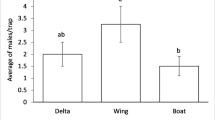Abstract—
The Integrated Pest Management (IPM) Programme under development at the International Crops Research Institute for the Semi-Arid Tropics (ICRISAT) calls for a proper monitoring system. Experiments conducted in groundnut fields at ICRISAT Center near Hyderabad, in peninsular India, to establish the optimum height for pheromone traps to monitor Spodoptera lituta (F), indicated that the male flight pattern changes considerably during the cropping period. During the seedling stage (sowing to 6 weeks), most moths were caught at 0.5 and 1.0 m. In the initial growth phase (7-11 weeks), the traps at 4.0 m caught most moths. During the optimum growth phase (12th week to harvest) of the crop the traps at 1.0 m height trapped most moths. After harvest, the traps at 4.0 m again recorded the highest catch. These data are interpreted in terms of the migration pattern of S. litura moths during the crop season. We suggest monitoring this species, using 1 m height traps.
Males were found to be more active around 0300 hr, with a small peak after sunset (2000 hr). Irrespective of season, the peak flight activity of this species was around 0300 hr in groundnut fields.
Résumé
Le programme de lutte intégrée développé à l’International Crops Research Institute for the Semi-Arid Tropics (ICRISAT) passe par la mise en place d’un système de surveillance efficace. Des expériences ont été menées dans des parcelles d’arachide au Center ICRISAT près d’Hyderabad (Inde) pour déterminer la hauteur optimum des pièges à phéromones utilisés pour surveiller les populations de Spodoptera litura F. Les résultats montrent que l’activité de vol des mâles varie pendant la période de croissance de l’arachide. Au stade plantule (semis à 6 semaines) la plupart des mâles sont capturés dans des pièges placés entre 0,5 et 1,0 de hauteur. Pendant la phase de croissance initiale (7-11 semaines) les pièges placés à 4,0 m, capturent plus de mâles. Après la récolte, les pièges placés à 4,0 m de hauteur capturent à nouveau le plus grand nombre de mâles. Ces résultats sont iterprétés en fonction de l’activité de vol de S. litura pendant la période de culture. Les pièges à phéromone placés à 1,0 m de hauteur nous semblent les plus efficaces pour évaluer le niveau d’abondance des populations de ce ravageur.
Les mâles sont plus actifs vers 0300 hr et, dans une moindre mesure, au crépuscule (2000 hr). Le pic d’activité de vol de ce ravageur se situe donc autour de 0300 hr dans les champs d’arachide, indépendemment de la saison.
Similar content being viewed by others
References
Ali Niaze M. T. (1983) Monitoring the filbert worm, Melissopus latiferreanus (Lepidoptera: Olethreutidae), with sex attractant traps. Effect of trap design and placement on moth catches. Environ. Entamol. 12, 141–146.
Arai S. and Iga M. (1985) Capture of male Spodoptera litura (Lepidoptera: Noctuidae) by sex attractant pheromone traps on the roof top of a taller building (203 m height) (in Japan). Proceedings of the Kanto-Tosan Protection Society 32, 174–175.
Ayyanna T., Arjuna Rao P., Subbaratnam G. V., Krishna Murthy Rao B. H. and Narayana K. L. (1982) Chemical control of Spodoptera litura Fabricius on groundnut crop. Pesticides 16, 19–20.
Balasubramanian G., Chelliah S. and Balasubramanian M. (1985) Studies on light trap and pheromome trap catches of Spodoptera litura Fabricius. Behavioural and Physiological Approaches in Pest Management (Edited by Raghupathy A. and Jayaraj S.), pp. 78–84. Tamil Nadu Agricultural University, Coimbatore, Tamil Nadu, India.
Dandapani N. (1985) Trapping of Spodoptera litura (F.) moths using sex pheromone. Madras Agric.J. 72, 236–238.
Krishnananda N. and Satyanarayana S. V. V. (1985) Effect of height of pheromone trap on the capture of Spodoptera litura moths in tobacco nurseries. Phytoparasitica 13, 59–62.
Madsen F. H. and Vakenti. J. M. (1973) Codling moth: use of codlemone baited traps and visual detection of entries to determine need of sprays. Environ. Entomol. 2, 677–679.
Minks A. K., De Jong D. J. (1975) Determination of spraying dates for Adoxophyes orana by sex pheromone traps and temperature recordings. J. econ. Entomol. 5, 729–732.
Moshe Kehat and Shaul Greenberg (1976) Field evaluation of the synthetic pheromone, as an attractant for males of the cotton leafworm Spodoptera lituralis (Boisd) in Israel. Appi. Entomol. Zool. 11, 45–52.
Pawar A. D. and Prasad J. (1983) Field evaluation of a sex pheromone “Litlure” as an attractant for males of Spodoptera litura (F.) (Lepidoptera: Noctuidae). Ind. J. Plant. Prot. 11, 108–109.
Ranga Rao G.V., Wightman J.A., and Ranga Rao D.V. (1990) The development of a standard pheromone trapping procedure for Spodoptera litura (F.) (Lepidoptera: Noctuidae) population in groundnut (Arachis hypogeae) crop. Trop. Pest Manage, (in press).
Riedl H. and Croft B. A. (1974) A study of pheromone traps catches in relation to codling moth damage. Can. Entomol. 106, 525–537.
Riedl H., Hoying S. Q., Barnett W. W. and DeTar J. S. (1979) Relationship of within tree placement of pheromone trap to codling moth catches. Environ. Entomol. 8, 765–769.
Tamaki Y., Naguchi H. and Yushima T. (1973) Sex pheromone of Spodoptera litura (F.) (Lepidoptera: Noctuidae): Isolation, identification and synthesis. Appi. Entomol. Zool. 8, 200–203.
Wong T. T. Y., Dolphin R. E. Cleveland M. L., Rolston D. F., Davis D. G. and Morizin T. E. (1971) Distribution and abundance of lesser peachtree borer on Washington Island, Wisconsin. J. econ. Entomol. 64, 879–882.
Yushima, T., Tamaki, Y., Kamano S. and Oyama M. (1974) Field evaluation of synthetic sex pheromone “Litlure” as an attractant for males of Spodoptera litura (F.) (Lepidoptera: Noctuidae). Appi. Entomol. Zool. 9, 147–152.
Author information
Authors and Affiliations
Additional information
Submitted as JA No. 872 by the International Crops Research Institute for the Semi-Arid Tropics (ICRISAT).
Rights and permissions
About this article
Cite this article
Ranga Rao, G.V., Wightman, J.A. & Ranga Rao, D.V. Monitoring Spodoptera Litura (F) (Lepidoptera: Noctuidae) Using Sex Attractant Traps: Effect of Trap Height and Time of the Night on Moth Catch. Int J Trop Insect Sci 12, 443–447 (1991). https://doi.org/10.1017/S1742758400011346
Received:
Revised:
Published:
Issue Date:
DOI: https://doi.org/10.1017/S1742758400011346




